Angels Flight
|
Angels Flight Railway (Sinai and Olivet) | |
|
Angels Flight in November 2008 | |
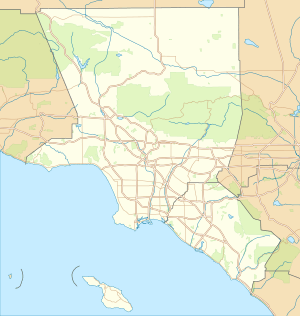   | |
| Location | Hill Street, Los Angeles, California |
|---|---|
| Coordinates | 34°3′4.82″N 118°15′0.76″W / 34.0513389°N 118.2502111°WCoordinates: 34°3′4.82″N 118°15′0.76″W / 34.0513389°N 118.2502111°W |
| Built | 1901 |
| Architect | Merceau Bridge & Construction Co.; Train & Williams |
| Architectural style | Beaux-Arts, and other. |
| NRHP Reference # | 00001168 |
| LAHCM # | 4 |
| Significant dates | |
| Added to NRHP | October 13, 2000[1] |
| Designated LAHCM | August 6, 1962[2] |
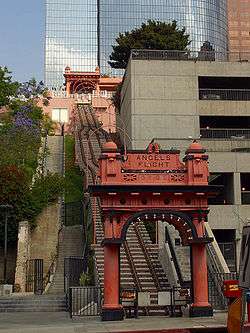
Angels Flight (or Angels's Flight) is a landmark 2 ft 6 in (762 mm) narrow gauge[3] funicular railway in the Bunker Hill district of Downtown Los Angeles, California. It has two funicular cars: Sinai and Olivet.
The funicular has operated on two different sites, using the same cars and station elements. The original Angels Flight location, with tracks connecting Hill Street and Olive Street, operated from 1901 until it was closed in 1969, when its site was cleared for redevelopment.
The second Angels Flight location opened nearby to the south in 1996, with tracks connecting Hill Street and California Plaza. It was re-closed in 2001, after a fatal accident, and took nine years to commence operations again, on March 15, 2010.[4] It was closed again from June 10, 2011, to July 5, 2011, and then again after a minor incident on September 5, 2013. The investigation of this 2013 incident led to the discovery of potentially serious safety problems in both the design and the operation of the funicular, and Angels Flight service has been suspended since that time with no timetable for restored service.[5][6] Before the 2013 service suspension, the cost of a one-way ride was 50 cents (25 cents for Metro pass holders).
Although it was marketed primarily as a tourist novelty, it was frequently used by local workers to travel between the Downtown Historic Core and Bunker Hill. Local businesses have described the railroad as an important "economic link", and there is significant political pressure to re-open the railroad soon.[7]
The original Angels Flight
Built in 1901 with financing from Colonel J.W. Eddy, as the Los Angeles Incline Railway, Angels Flight began at the west corner of Hill Street at Third and ran for two blocks uphill (northwestward) to its Olive Street terminus. Angels Flight consisted of two vermillion "boarding stations" and two cars, named Sinai and Olivet, pulled up the steep incline by metal cables powered by engines at the upper Olive Street station. As one car ascended, the other descended, carried down by gravity.[8][9][10][11] An archway labeled "Angels Flight" greeted passengers on the Hill Street entrance, and this name became the official name of the railway in 1912 when the Funding Company of California purchased the railway from its founders.[12]
The original Angels Flight was a conventional funicular, with both cars connected to the same haulage cable. Unlike more modern funiculars it did not have track brakes for use in the event of cable breakage, but it did have a separate safety cable which would come into play in case of breakage of the main cable. It operated for 68 years with a good safety record.[13]
The only fatality that involved the original Angels Flight occurred in the autumn of 1943, when a sailor attempting to walk up the track was crushed beneath one of the cars.[12]
In November 1952, the Beverly Hills Parlor of the Native Daughters of the Golden West erected a plaque to commemorate fifty years of service by the railway.
- The plaque reads:
— Built in 1901 by Colonel J.W. Eddy, lawyer, engineer and friend of President Abraham Lincoln, Angels Flight is said to be the world's shortest incorporated railway. The counterbalanced cars, controlled by cables, travel a 33 percent grade for 315 feet. It is estimated that Angels Flight has carried more passengers per mile than any other railway in the world, over a hundred million in its first fifty years. This incline railway is a public utility operating under a franchise granted by the City of Los Angeles. —[14]
In 1962, at its first meeting, the city's new Cultural Heritage Board designated Angels Flight a Los Angeles Historic-Cultural Monument (No. 4), along with four other locations. Los Angeles was early in enacting preservation laws, and the first sites chosen each were "considered threatened to some extent," according to the history of the board, now the Cultural Heritage Commission.[2]
Dismantling
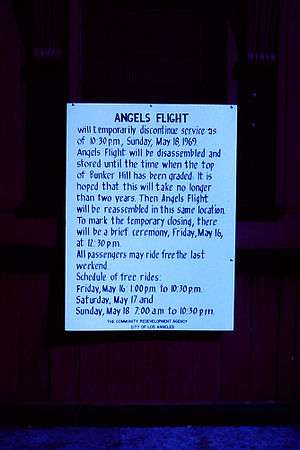
The railway was closed on May 18, 1969[15][16][17] when the Bunker Hill area underwent a controversial total redevelopment which destroyed and displaced a community of almost 22,000 working-class families renting rooms in architecturally significant but run-down buildings, to a modern mixed-use district of high-rise commercial buildings and modern apartment and condominium complexes. Both of the Angels Flight Cars, Sinai and Olivet were then placed in storage at 1200 S. Olive Street, Los Angeles. This was the location of Sid and Linda Kastner's United Business Interiors. At this location the Kastners maintained a private museum "The Bandstand". The Bandstand featured Antique Coin Operated Musical Instruments where one of the cars (Sinai) was on display in the museum. Olivet was stored in the garage of the building. They were stored at this location for 27 years at no charge in anticipation of the railway's restoration and reopening.
Reconstruction
After being stored for 27 years, the funicular was rebuilt and reopened on February 24, 1996, half a block south of the original site.[18] Although the original cars, Sinai and Olivet, were used, a new track and haulage system was designed and built, a redesign which had unfortunate consequences five years later. As rebuilt, the funicular was 91 meters (298.6 feet) long on an approximately 33-percent grade.
Car movement was controlled by an operator inside the upper station house, who was responsible for visually determining that the track and vehicles were clear for movement, closing the platform gates, starting the cars moving, monitoring the operation of the funicular cars, observing car stops at both stations, and collecting fares from passengers. The cars themselves did not carry any staff members.[13] Angels Flight was added to the National Register of Historic Places on October 13, 2000.
2001 Accident
On February 1, 2001, Angels Flight had a serious accident that killed a passenger, Leon Praport (age 83), and injured seven others, including Praport's wife, Lola. The accident occurred when car Sinai, approaching the upper station, reversed direction and accelerated downhill in an uncontrolled fashion to strike car Olivet near the lower terminus.[13]
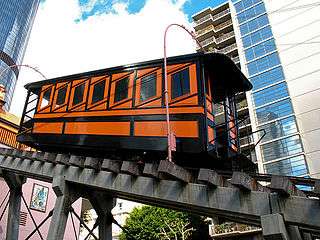
The National Transportation Safety Board (NTSB) conducted an investigation into the accident and determined that the probable cause was the improper design and construction of the Angels Flight funicular drive and the failure of the various regulatory bodies to ensure that the railway system conformed to initial safety design specifications and known funicular safety standards. The NTSB further remarked that the company that designed and built the drive, control, braking, and haul systems, Lift Engineering/Yantrak, is no longer in business and that the whereabouts of the company's principal is unknown.[13]
Unlike the original, the new funicular used two separate haulage systems (one for each car), with the two systems connected to each other, the drive motor, and the service brake by a gear train; it was the failure of this gear train that was the immediate cause of the accident since it effectively disconnected Sinai both from Olivet’s balancing load and from the service brake. There were emergency brakes that acted on the rim of each haulage drum, but due to inadequate maintenance the emergency brakes for both cars were inoperative, which left Sinai without any brakes once its physical connection to the service brake was lost. Contrary to what might be expected, the new funicular was constructed with neither safety cable nor track brakes, either of which would have prevented the accident; the NTSB was unable to identify another funicular worldwide that operated without either of these safety features.[13]

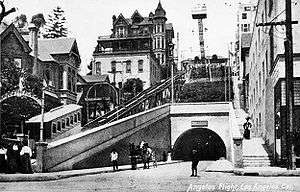
Records indicate that the emergency brake had been inoperative for 17 to 26 months due to the fact that a normally closed hydraulic solenoid valve had been placed in a location where the design called for a normally open valve and that its ill fitted solenoid was burned out.
During the 17 to 26 months that the emergency braking system was not operating, the braking system was tested daily, but since the service brake and emergency brake were tested simultaneously, there was no way to tell if the emergency brake was functioning without looking at the brake pads or hydraulic pressure gauges during the test. The test was always performed with the Sinai car traveling uphill, which meant that when the power was cut and the brakes applied (as part of the test), Sinai’s momentum caused the car to continue moving uphill a short distance (slackening the cable) and then to roll back from gravity, jerking the cable tight.
If the emergency brakes had been functional, they would have caught Sinai when the cable snapped tight, but without the emergency brakes, the force of the jerk caused by the daily test was directed through the spline (the part that failed) and to the service brake. In addition, it was found that the original design called for the spline to be made of AISI 1018 steel on one drawing and of AISI 8822 steel on a different drawing, but it is unlikely that this ambiguity in the design contributed to the accident.[19] However, regular analysis of gear box oil-samples was discontinued in May 1998, despite the fact that the company performing the tests recommending that the rising particulate level in the oil samples warranted the test occurring more frequently.[13] The continued rising particulate level may have been in part caused by unusual wear of the splines. Continued testing could have resulted in an inspection to locate the cause of the unusual wear.
Besides the design failures in the haulage system, the system was also criticised by the NTSB for the lack of gates on the cars and the absence of a parallel walkway for emergency evacuation. The funicular suffered serious damage in the accident.
Evaluation
The death and injuries could have been avoided if any one of the following had taken place:[19]
- The 1996 renovation had included installing track brakes or safety cables.
- The biannual oil analysis tests had not been discontinued in May 1998 (which would have shown rising levels of particulate material in the oil and may have caused a full inspection of the system to take place).
- A single haulage system, similar to the first Angels Flight, had been used rather than the system that had separate cables for each car.
- The emergency brake hydraulic solenoid valve had been installed according to the design (as normally open). But if the brake fluid had been changed as instructed in the maintenance manual, this would not have happened.
- The technician installing the solenoid had obtained a properly fitting part when discovering the solenoid did not properly fit the valve, instead of forcing it in with a tool (The installed valve was a newer design, for which the older solenoid was dimensionally incompatible, and tool marks on the solenoid show that it was forced in).
- The daily brake test had included testing the service brake and emergency brake separately instead of testing them simultaneously (which made it impossible to confirm that they were both working).
- The daily brake test procedure had included looking at the brake pads and the hydraulic pressure in the emergency brake system to confirm it was operating.
- The pressure gauges for the hydraulic brake systems had been placed on the operator's control panel instead of in the equipment cabinet.
- The daily brake test had involved applying the brakes more gradually so that the up-hill-bound car would not have the momentum to produce slack in the cable and roll backwards, jerking the cable tight.
- The splines (the part that failed) had been designed to be extraordinarily strong to withstand the excessive force that occurred when the brake test was performed and the emergency brake was inoperative (which resulted in the force of the cable being pulled tight to be directed to the service brake through the splines, rather than to the emergency brake which was before the splines).
Repaired
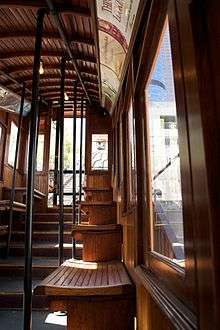
On November 1, 2008, both of the repaired and restored Angels Flight cars, Sinai and Olivet, were put back on their tracks and, on January 16, 2009, testing began on the railway.[20][21] On November 20, 2009, another step in the approval process was achieved.[22] On March 10, 2010, the California Public Utilities Commission approved the safety certificate for the railroad to begin operating again.[23][24]
The new drive and safety system completely replaced the system which was the cause of the fatal 2001 accident. Like the original Angels Flight design and most traditional funicular systems, the new drive system incorporates a single main haulage cable, with one car attached to each end. Also like the original design, a second safety cable is utilized. To further enhance safety, unlike the original design, each car now has a rail brake system, as a backup to the main backup emergency brakes on each bull-wheel. Another added safety feature is an independent evacuation motor to move the cars should the main motor fail for any reason.[25]
Reopening and temporary closing
Angels Flight reopened to the public for riding on March 15, 2010. The local media covered the event with positive interest.[26] Only a month after re-opening, Angels Flight had had over 59,000 riders.[27] Today it connects the Historic Core and Broadway commercial district with the hilltop Bunker Hill California Plaza urban park and the Museum of Contemporary Art - MOCA. The cost of a one-way ride is currently 50 cents, 25 cents with TAP card.
On June 10, 2011, the California Public Utilities Commission ordered Angels Flight to immediately cease operations due to wear on the steel wheels on the two cars. Inspectors determined that their fifteen-year-old wheels needed replacing.[28] It reopened on July 5, 2011, after eight new custom-made steel wheels were installed on the two cars.[29]
2013 accident
On September 5, 2013, one car derailed near the middle of the guideway. One passenger was on board the derailed car, and five passengers were on board the other car. There were no injuries. Passengers had to be rescued from the cars by firefighters. The brake safety system had been bypassed with a wooden stick.[6][30]
The National Transportation Safety Board determines the probable cause of the September 5, 2013, accident was the intentional bypass of the funicular safety system with Angels Flight management knowledge; and Angels Flight management continuation of revenue operations despite prolonged, and repeated, unidentified system safety shutdowns.— National Transportation Safety Board, Railroad Accident Brief [6]
The NTSB also noted a problem with the basic design: "The car body and the wheel-axle assembly are not articulated." The passing section of the track involves a short turning section which allows the cars to pass each other. The axles do not turn to follow the track, resulting in the wheel flanges grinding against the rail, causing excessive wheel wear. This problem, combined with safety system problems which caused unwanted track brake deployment, resulted in a derailment.[6] Angels Flight remains closed pending resolution of all these problems.
In arts and popular culture
Art
- Angel's Flight is the title of a famous 1931 oil painting by Millard Sheets that hangs as part of the permanent collection in the Los Angeles County Museum of Art. It shows two young women on the funicular's upper platform looking down on the nearby houses of Third Street, but the funicular cars themselves are out of the frame.
Film and video
- There is a brief shot of the Angels Flight in the introduction of the Dragnet episode "Narcotics DR-21".
- Angels Flight debut on film was probably Good Night, Nurse! (1918), but it got its first real close-up in a 1920 one-reel comedy of errors, All Jazzed Up.
- Angels Flight is featured in a 20-second sequence showing the two cars passing in the film Night Has a Thousand Eyes (1948).
- Angels Flight is seen through the windows a couple of times during the 'planning' scene in the noir film Criss Cross (1949).
- Angles Flight appeared in the 1951-53 TV series, The Adventures of Boston Blackie, which was set in Los Angeles. (I personally remember this; the only reference to it online that I can find is.[31] It is hard to find detailed information on the TV series. Also, if anyone can clean up and properly format this line, I'd appreciate it.)
- Angels Flight features in the 1952 crime thriller The Turning Point, with William Holden and Alexis Smith taking a ride up it to follow a lead.
- In Cry of the Hunted (1953), Jory (Vittorio Gassman), a prisoner being transported, escapes and rides the Angels Flight to evade capture.
- Angels Flight appears in The Glenn Miller Story (1954). Early in the film when Miller (James Stewart) visits a pawn shop on Clay Street, the adjacent Angels Flight is clearly visible.
- Angels Flight appears in the 1955 film Kiss Me Deadly at about 55'45", as Ralph Meeker (Mike Hammer) drives under it to park and visit one of the old Bunker Hill mansions which had been turned into a flophouse and in which a "person of interest" in his case resides.
- Angels Flight appears in the 1956 film Indestructible Man at about 40'00". Lon Chaney Jr. rides up to Olive Street and the Hillcrest Hotel. Marian Carr later rides down to Hill Street. In one scene, you can barely make out a sign showing the cost to ride Angel's Flight is "ROUND TRIP OR TWO RIDES - 5 CENTS" and "30 RIDE BOOK - 50 CENTS".
- The 1956 Kent Mackenzie short film Bunker Hill: A Tale of Urban Renewal features Angels Flight.
- Angels Flight is seen several times in the 1961 Kent Mackenzie film The Exiles, which dramatizes the lives of several real Native Americans living on Bunker Hill in 1958 (when the film was shot). The DVD of The Exiles also includes the 1956 Kent Mackenzie short film Bunker Hill: A Tale of Urban Renewal and the 1969 short film, The Last Day of Angels Flight..
- In 1963 the railway appeared in the cult trash horror classic The Incredibly Strange Creatures Who Stopped Living and Became Mixed-Up Zombies, where one of the characters walks up the hill alongside the tracks.
- Angel's Flight is a low-budget 1965 film noir about a Bunker Hill serial killer, shot on and around Angels Flight in both the downtown and Bunker Hill neighborhoods.
- There is a scene shot on the railway in They Came to Rob Las Vegas released in 1968.
- The only color episode of the original Perry Mason TV series, "The Case of the Twice-Told Twist", originally aired in February 1966 during its final season, has a brief scene in the opening act, where Perry (Raymond Burr) and his secretary Della Street (Barbara Hale) take a ride on the Angel's Flight railway.
- Edmund Penney's 15-minute documentary from 1969, Angels Flight Railway', features footage shot in 1965 and during the funicular's last days in 1969.
- The Last Day of Angels Flight was a documentary filmed on the day the railway closed in March 1969.
- On November 23, 2010, NBC's The Biggest Loser featured the ride in part of a challenge in which the contestants have to either walk the stairs for 5 points or take the train for 1 point. The winner, accumulating 100 points, won a 2011 Ford Edge.
- Angels Flight is featured in The Muppets (2011) when Jason Segel's character sings the Academy Award-winning song "Man or Muppet".
- Angels Flight is seen during a street chase scene in the 1948 film Hollow Triumph. Paul Henreid's character kicks the man chasing him off the back of the car as it ascends.
- Sebastian Wilder (Ryan Gosling) and Mia Dolan (Emma Stone) ride the Angels Flight railway in the 2016 film La La Land.
Literature
- There are at least five novels titled Angel's Flight or Angels Flight, all with scenes that take place on the funicular and use it as a symbol of some kind. The first novel was Angel's Flight by Don Ryan, published in 1927. Angels Flight was both the name and locale of the 1999 Harry Bosch crime novel by Michael Connelly.
- Raymond Chandler fictionally visited Angels Flight in the 1938 novella The King in Yellow and the 1942 novel The High Window. Marlowe visits the Bunker Hill area in The Little Sister as well.
- In the 1967 Nick Carter spy novel The Red Guard, Carter takes the Angels Flight to reach his safe house located half a block from the upper station.
- Angel's Flight is illustrated and at the center of events in the 1965 children's book "Piccolo's Prank" by Leo Politi.
Music
- The City of Los Angeles commissioned conductor David Woodard to compose and perform a memorial suite, entitled "An Elegy for Two Angels," in honor of Leon Praport and the funicular itself. The work was first performed at the Hill Street entrance by the Los Angeles Chamber Group on March 15, 2001, during a civic ceremony in which the autograph score was awarded to Praport's widow Lola.[32][33]
- There are references to Angels Flight in the song "Strange Season" on Michael Penn's 1992 album Free-for-All, and the cover features images of the line and a ticket stating, "Good for one ride".
Games
- In the game Tony Hawk's American Wasteland, Angels Flight is a gap where the player can grind up or down the rails, the gap being called "Angel Going Up!" or "Angel Going Down!"
- The game L.A. Noire features Angels Flight as one of 30 landmarks across the city. It is the location of the Street Crime side mission, "Shoo-Shoo Bandits"
See also
References
- ↑ National Park Service (2008-04-15). "National Register Information System". National Register of Historic Places. National Park Service.
- 1 2 https://web.archive.org/web/20100916060240/http://preservation.lacity.org/commission/history. Archived from the original on September 16, 2010. Retrieved June 8, 2010. Missing or empty
|title=(help) - ↑ Thompson, Joe (October 1, 2013). "Los Angeles Area Funiculars". Cable Car Guy (blog).
- ↑ DiMassa, Cara Mia (March 15, 2010). "Angels Flight rides again". Los Angeles Times. Archived from the original on March 22, 2010. Retrieved March 18, 2010.
- ↑ Schaefer, Samantha (September 5, 2013). "Angels Flight car comes off track, stranding Australian tourist". Los Angeles Times. Retrieved 2013-09-06.
- 1 2 3 4 "Railroad Accident Brief - Angels Flight Railway Derailment" (PDF). National Transportation Safety Board. June 23, 2014. Accident No. DCA13FR011.
- ↑ Nelson, Laura J. & Branson-Potts, Hailey (July 23, 2015). "L.A. business and cultural leaders want to see an Angels Flight plan". Los Angeles Times.
- ↑ Harrison, Scott (January 7, 2011). "Angels Flight's first opening". Los Angeles Times.
- ↑ "Mayor Snyder's Ascent of the "Angels' Flight"". Los Angeles Times. January 1, 1902. p. 12. (subscription required (help)). Alternate Link via ProQuest.
- ↑ "Up Again, Down Again: It Will Take Two Minutes, Perhaps Three, for the Round Trip on the Angels' Flight". Los Angeles Times. November 21, 1901. p. 11. (subscription required (help)). Alternate Link via ProQuest.
- ↑ "Angels' Flight Publicly Opened: Novel Enterprise Is Visited by City Officials Mayor Snyder Makes a Speech Congratulating Colonel Eddy Upon His Scheme to Afford Transportation for Residents of the Hill Section". Los Angeles Herald. 29 (92). 1 January 1902. p. 9 – via California Digital Newspaper Collection.
- 1 2 Wheelock, Walt (1961). Angels Flight: A California Heritage. Glendale, CA: La Siesta Press. p. 16.
- 1 2 3 4 5 6 "Uncontrolled Movement, Collision, and Passenger Fatality on the Angels Flight Railway in Los Angeles, California - February 1, 2001" (PDF). National Transportation Safety Board. Archived from the original (pdf) on October 22, 2011. Retrieved January 22, 2007.
- ↑ Wheelock, Walt (1961). Angels Flight: A California Heritage. Glendale, CA: La Siesta Press. p. 20.
- ↑ "Angels Flight to Make Final Run May 18". Los Angeles Times. May 8, 1969. p. D2. (subscription required (help)). Alternate Link via ProQuest.
- ↑ Hebert, Ray (May 12, 1969). "Angels Flight Now Running Out Its Last Few Journeys: Angels Flight Making Last Runs This Week". Los Angeles Times. p. OC_A1. (subscription required (help)). Alternate Link via ProQuest.
- ↑ "Angels Flight--End of an Era". Los Angeles Times. May 13, 1969. p. A8. (subscription required (help)). Alternate Link via ProQuest.
- ↑ Gordon, Larry (February 25, 1996). "Maiden Voyage: Historic Angels Flight Railway Reopens to Public With Plenty of Revelry and a Wisp of Nostalgia". Los Angeles Times.
- 1 2 "Angels Flight Accident". Consultants' Bureau. Kashar Technical Services. May 3, 2007. Retrieved December 26, 2008.
- ↑ Alossi, Rich (January 16, 2009). "history in motion: angels flight takes off!". angelinic. Archived from the original on January 22, 2009. Retrieved January 17, 2009.
- ↑ "Angels Flight". Glass Steel and Stone. Archived from the original on January 15, 2010. Retrieved November 14, 2008.
- ↑ http://la.curbed.com/tags/angels-flight
- ↑ DiMassa, Cara Mia (March 10, 2010). "Nine years after fatal accident, Angels Flight rail line receives safety certificate". Los Angeles Times. Archived from the original on April 15, 2010. Retrieved March 14, 2010.
- ↑ DiMassa, Cara Mia (March 11, 2010). "Angels Flight railway gets PUC safety OK". Los Angeles Times. Archived from the original on April 15, 2010. Retrieved March 14, 2010.
- ↑ "Historic Angels Flight Railway Reopens" (PDF) (Press release). Angels Flight Railway Foundation. March 15, 2010. Archived from the original (PDF) on March 4, 2012. Retrieved June 21, 2012.
- ↑ Cart, Julie (March 14, 2010). "Angels Flight to reopen Monday". Los Angeles Times. Retrieved March 14, 2010.
- ↑ "Angels Flight Hits Nearly 60,000 Riders". Los Angeles Downtown News. April 16, 2010. Retrieved April 27, 2010.
- ↑ Knoll, Corina (June 11, 2011). "Angels Flight, halted, awaits new wheels". Los Angeles Times. Retrieved June 11, 2011.
- ↑ Barboza, Tony (July 5, 2011). "Angels Flight railway reopens after safety shutdown". Los Angeles Times. Retrieved July 5, 2011.
- ↑ Schaefer, Samantha; Mather, Kate & Gold, Scott (October 11, 2013). "Angels Flight has had a long, bumpy track record". Los Angeles Times. Retrieved 2014-07-31.
- ↑ http://www.freerepublic.com/focus/f-chat/2858405/posts
- ↑ Reich, K., "Family to Sue City, Firms Over Angels Flight Death", Los Angeles Times, Mar. 16, 2001.
- ↑ Dawson, Jim (2008). Los Angeles's Angeles Flight. Mt. Pleasant, SC: Arcadia Publishing. p. 125. ISBN 978-0738558127.
External links
| Wikimedia Commons has media related to Angels Flight. |
- Official Angel's Flight website
- An Elegy for Two Angels
- Angels Flight Virtual Ride
- Angel's Flight at the Internet Movie Database
- Stills from movies featuring Angels Flight
- KTLA News Clip covering proposed reopening on YouTube
- A ride on Angels Flight on YouTube
- memory.loc.gov. Official L.o.C. HABS/HAER/HALS website

_edit1.jpg)

